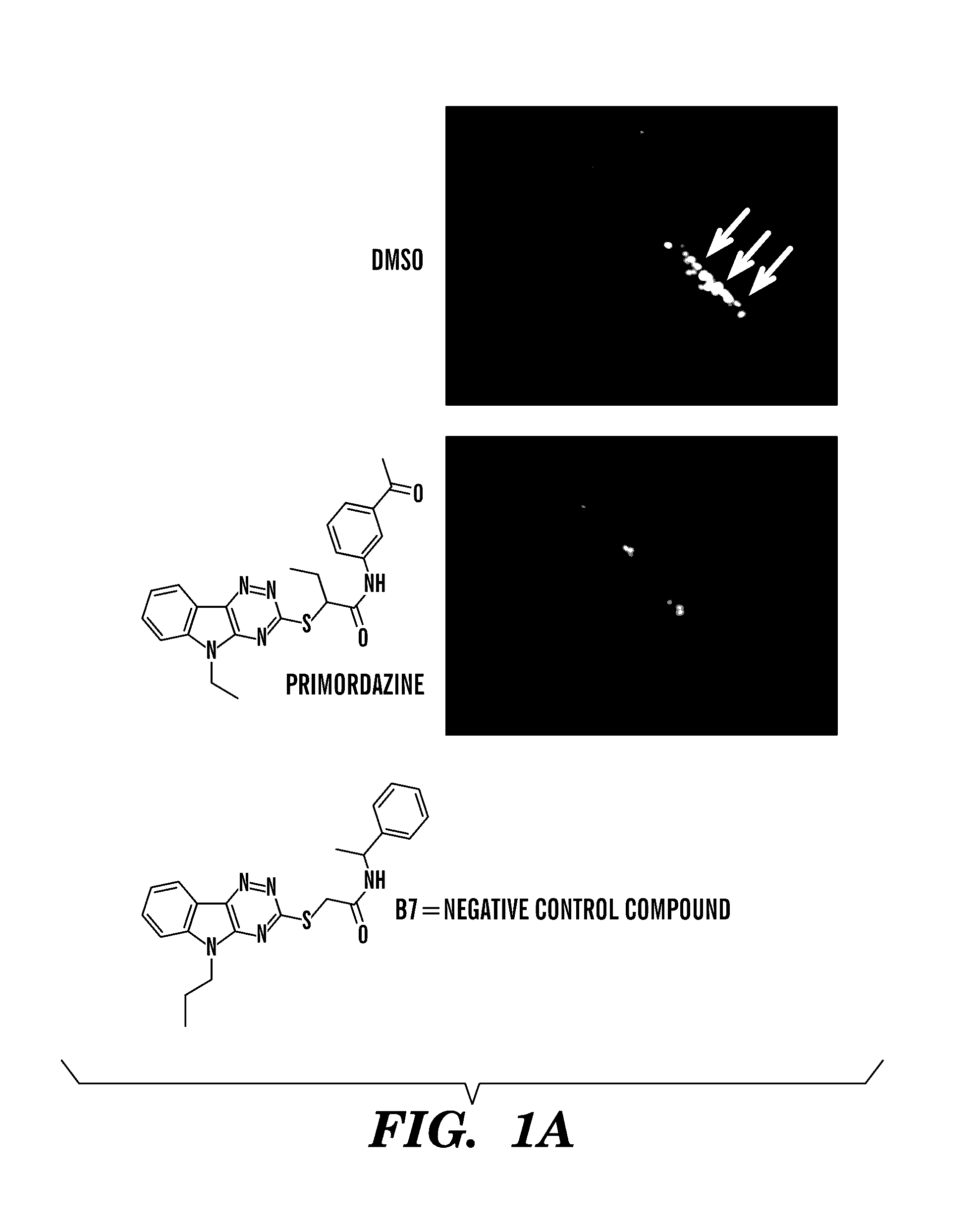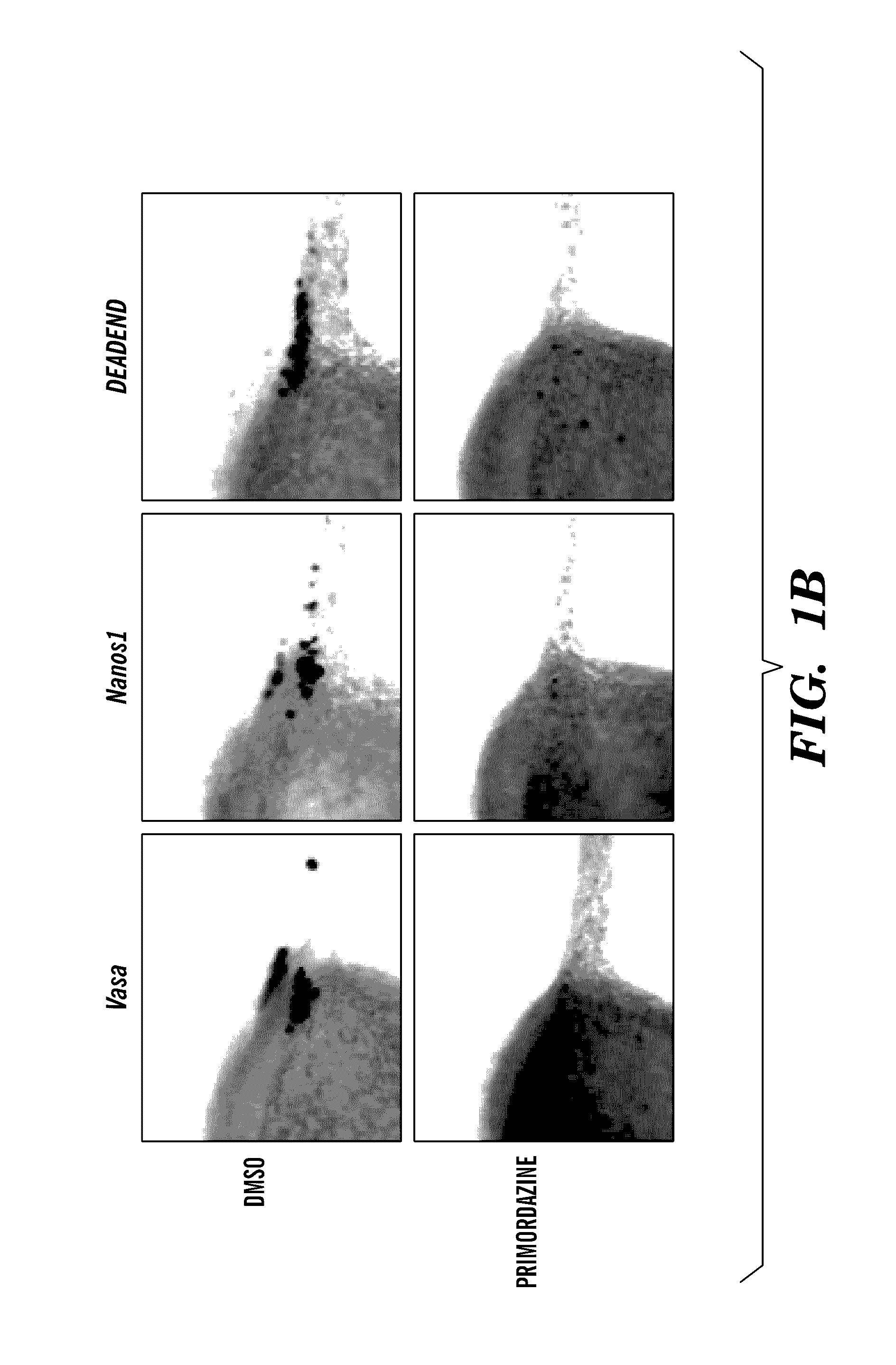Germ cell ablation compounds and uses thereof
a technology of germ cell and compound, applied in the field of germ cell ablation compounds, can solve the problems of growing seafood deficit, unable to meet demand, and $7 billion annual trade deficit in edible fishery products, and achieve the effect of less gonad
- Summary
- Abstract
- Description
- Claims
- Application Information
AI Technical Summary
Benefits of technology
Problems solved by technology
Method used
Image
Examples
example 1
Effects of Primordazine on Protein Localization and Interaction with the PRE Primordazine Ablates PGCs
[0159]In an effort to discover pathways essential for PGC maintenance, a small molecule screen for compounds that promote disappearance of PGCs was performed. The screen was performed with transgenic zebrafish embryos that express GFP exclusively in PGCs. Of 7,000 small molecules screened, three caused disappearance of PGCs without causing other observable changes in embryonic development. The three PGC-ablating compounds were close structural analogs of each other, and the representative compound from this class was named primordazine (FIG. 1A). Treatment of embryos with primordazine ablates PGCs in a dose-dependent manner, but only when treatment begins prior to 4 hours postfertilization. PGC loss was confirmed by multiple PGC lineage markers (FIG. 1B).
Primordazine Functions Through a 40-Base Response Element in 3′ UTRs
[0160]During the process of confirming PGC loss in primordazin...
example 2
Determination of the Localization of KHSRP, TIAL1, and DHX9 in Germ Cells+ / − Primordazine Treatment
[0165]The cDNAs for khsrp, tial1, and dhx9 have been cloned into an expression vector that allows each protein to be expressed as a GFP fusion in germ cells. Germ cell specific expression is achieved by inclusion of the mir430 site in the 3′ UTR of each mRNA. RNA encoding individual protein-GFP fusions is injected into 1-cell stage zebrafish. The localization of the protein-GFP fusion within the germ cells is determined by confocal microscopy at 6, 11, and 24 hpf. The effect of primordazine on localization is also determined by treating embryos with primordazine from 2-5 hpf and determining localization at 6, 11, and 24 hpf.
[0166]In addition to characterizing the localization of the three proteins within the germ cells of live zebrafish, localization of the proteins relative to nanos1 RNA localization is characterized. For these studies, animals are fixed at 6, 11, and 24 hpf and subje...
example 3
Quantify Binding of KHSRP and TIAL1 to the Primordazine Response Element in Vitro
[0168]Both KHSRP and TIAL1 were identified by mass spectrometry after binding to a biotinylated PRE oligonucleotide. It is important to verify binding by an orthogonal technique and to quantify the effect of primordazine treatment on binding. The protein-GFP fusions described above are expressed in zebrafish embryos. Embryos are treated with primordazine or DMSO. Embryos are lysed, and biotinylated PRE oligonucleotides are added to the lysate. Magnetic streptavidin beads can be used to precipitate the PRE oligo and associated proteins, which are separated by SDS-PAGE and detected by anti-GFP western blot.
[0169]Binding of KHSRP and TIAL1 to the PRE is confirmed by western blot. Changes in binding upon treatment with primordazine are detected. This supports the fact that KHSRP or TIAL1 is functionally involved in the primordazine mechanism of action. When neither KHSRP nor TIAL1 exhibits altered binding t...
PUM
 Login to View More
Login to View More Abstract
Description
Claims
Application Information
 Login to View More
Login to View More - R&D
- Intellectual Property
- Life Sciences
- Materials
- Tech Scout
- Unparalleled Data Quality
- Higher Quality Content
- 60% Fewer Hallucinations
Browse by: Latest US Patents, China's latest patents, Technical Efficacy Thesaurus, Application Domain, Technology Topic, Popular Technical Reports.
© 2025 PatSnap. All rights reserved.Legal|Privacy policy|Modern Slavery Act Transparency Statement|Sitemap|About US| Contact US: help@patsnap.com



